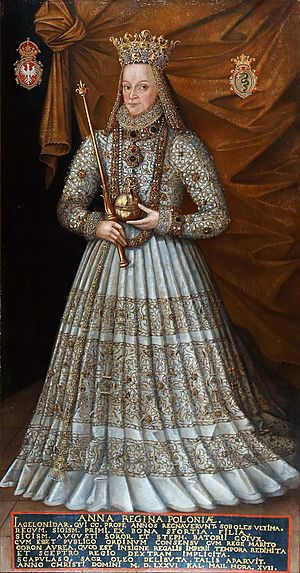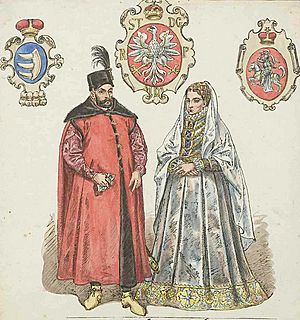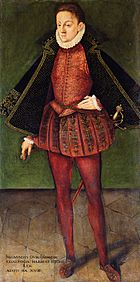Anna Jagiellon facts for kids
Quick facts for kids Anna Jagiellon |
|
|---|---|

Queen Anna in her coronation robes (1576 painting by Martin Kober)
|
|
| Queen of Poland Grand Duchess of Lithuania |
|
| Reign | 15 December 1575 – 19 August 1587 |
| Coronation | 1 May 1576 in Kraków |
| Predecessor | Henry de Valois |
| Successor | Sigismund III Vasa |
| Co-monarch | Stephen Báthory |
| Princess consort of Transylvania | |
| Reign | 1 May 1576 – 12 December 1586 |
| Born | 18 October 1523 Kraków, Kingdom of Poland |
| Died | 9 September 1596 (aged 72) Warsaw, Polish–Lithuanian Commonwealth |
| Burial | 12 November 1596 Wawel Cathedral |
| Spouse | |
| Dynasty | Jagiellon |
| Father | Sigismund I the Old |
| Mother | Bona Sforza |
| Religion | Roman Catholicism |
| Signature |  |
Anna Jagiellon (born October 18, 1523 – died September 9, 1596) was a powerful queen who ruled Poland and Lithuania from 1575 to 1587. She was known as the Queen of Poland and Grand Duchess of Lithuania.
Anna was the daughter of Polish King Sigismund I the Old and Italian Duchess Bona Sforza. Even though she received many offers, she stayed unmarried until she was 52 years old. After her brother, King Sigismund II Augustus, passed away, Anna became very important. He was the last male member of the Jagiellonian dynasty, a famous royal family.
Many people wanted to marry Anna to keep the royal family's tradition going. She was chosen as a co-ruler with her fiancé, Stephen Báthory, in 1576. This happened during a special election in the Polish-Lithuanian Commonwealth, a large country made up of Poland and Lithuania. Their marriage was more of a formal agreement than a close relationship.
While her husband, Stephen Báthory, was busy fighting in the Livonian War, Anna focused on managing local affairs. She also started several building projects, like a city wall to protect a bridge. After Stephen Báthory died in 1586, Anna could have ruled alone. Instead, she helped her nephew, Sigismund III Vasa, become king. His rule started the House of Vasa dynasty in Poland, which lasted for about 80 years.
Contents
Early Life

Growing Up Royal
Anna Jagiellon was born in Kraków, Kingdom of Poland, on October 18, 1523. Her parents were the King and Queen of Poland, Sigismund I the Old and Bona Sforza. She spent most of her childhood in Kraków with her younger sisters, Sophia and Catherine.
Sometimes, her parents and older brother, Sigismund II Augustus, traveled to Lithuania. This meant Anna and her sisters spent time alone in Kraków. Because of this, the three sisters became very close. However, they were not as close to their older brother.
A Princess's Education
Like all her brothers and sisters, Anna received an excellent education. She learned a lot about architecture (designing buildings) and finances (managing money). She could speak Italian and Latin very well.
In her free time, Anna loved to embroider and sew beautiful tapestries. Many of her amazing artworks still exist today! She also enjoyed playing chess and dice games. Anna was also involved in helping others through charity work.
Finding a Husband

Many Proposals, No Marriage
Finding husbands for Anna and her younger sisters was not a top priority for their parents. After their father died in 1548, the first serious person who wanted to marry Anna appeared. This was Albert Alcibiades, Margrave of Brandenburg-Kulmbach. However, he was a Protestant, had many debts, and a bad temper.
In 1548, Anna's mother, Queen Bona, and her unmarried daughters moved to Mazovia, mainly Warsaw. Queen Bona tried to arrange marriages for Anna with other princes. But these plans did not work out.
Anna's brother, King Sigismund II Augustus, also looked for husbands for his sisters. He considered kings and dukes from other countries. But he often changed his mind or didn't follow through. In 1556, Anna's sister Sophia finally got married. A month later, Queen Bona went back to her home country, Italy. This left Anna and her other unmarried sister alone in Warsaw.
Later, Sigismund II Augustus brought his sisters to Vilnius. Anna was already in her mid-thirties, but her brother kept looking for a husband for her. Many rulers were considered, but none worked out. For example, the Russian Tsar Ivan the Terrible was not seen as a good match for Poland.
Another proposal was John, Duke of Finland, who wanted to marry Anna's younger sister, Catherine. It was unusual for a younger sister to marry before an older one. So, Catherine's wedding was delayed. Anna agreed to let Catherine marry first, even though it must have been embarrassing for her. Catherine married John on October 4, 1562.
Anna then moved to the Royal Castle in Warsaw and lived there for about ten years. She spent her time playing games, embroidering, praying, and writing letters to her sisters. Her brother visited her every year. Even though Anna was in her forties, people still suggested marriages for her. But none of these plans ever worked out.
Becoming Queen
The First Election
In July 1572, Anna's brother, King Sigismund II Augustus, died. This left the throne of the Polish-Lithuanian Commonwealth empty. His death completely changed Anna's life. She was no longer just a forgotten princess; she became the most important person in the Jagiellon dynasty.
King Sigismund had left all his family's wealth to his three sisters. However, Polish nobles did not allow private people to inherit royal property. So, Anna received only a small part of her inheritance, but she still became a very rich woman.
A French diplomat suggested that Henry de Valois, a French prince, should become the next King of Poland. The diplomat promised that Henry would marry Anna to keep the royal family tradition alive. Anna learned about this promise and strongly supported Henry. She was happy that he seemed to care about her, not just the kingdom.
With Anna's help, Henry was elected King of Poland on May 11, 1573. He was crowned on February 21, 1574. But Henry's agreement did not actually include the promise to marry Anna. He kept delaying the marriage. When it became clear that Henry would not marry her, Anna felt very embarrassed. In June 1574, Henry left Poland to become King of France. By May 1575, the Polish Parliament had removed him as their monarch.
A New King and Queen
During the time the throne was empty again, Anna took on a special title: Infanta. This was like a Spanish princess title and showed her important royal status. Even though Poland did not usually have a "crown prince" because kings were elected, Anna called herself "Anna, by the Grace of God, Infanta of the Kingdom of Poland."
She still wanted to marry and become Queen of Poland. But after being tricked by the French, she was much more careful. She was doubtful about new marriage proposals. In December 1575, a diplomat named Jan Zamoyski suggested that Anna herself should be elected queen.
However, old laws did not allow an unmarried woman to rule alone. So, Stephen Báthory, a leader from Transylvania, was suggested as her husband. On December 15, 1575, Anna and Báthory were elected as co-rulers of the Polish-Lithuanian Commonwealth. Some Lithuanian nobles did not agree at first. But on June 29, 1576, after the coronation, they finally accepted the new King and Queen.
Anna's Reign
On February 28, 1576, Anna arrived in Kraków as the officially elected queen. Stephen Báthory joined her on April 23. On May 1, they were married and crowned at Wawel Cathedral. Queen Anna spent most of her time in Warsaw and Ujazdów Castle.
Building and Creating
After she became queen, Anna had to give up some of the inheritance from her brother. But in return, she received other valuable properties and a lot of money. She got income from the Wieliczka Salt Mine and interest from a loan her mother had given to the King of Spain.
With this significant income, Anna paid for and oversaw several large building projects. She finished rebuilding the Royal Castle in Warsaw and Ujazdów Castle. She also completed the Sigismund Augustus Bridge over the Vistula River. This was the longest wooden bridge in Europe at the time, about 500 meters long.
To protect the wooden bridge from fire, she built a city wall called Stara Prochownia, also known as the Bridge Gate. Anna also built a tomb monument for her brother in the Sigismund's Chapel. Later, she built her own tomb in the same chapel. She also paid for her mother's tomb in Italy.
A Distant Marriage

Even though there were rumors that Anna could still have children, her marriage to Stephen Báthory was mostly formal. They were not close and saw each other only a few weeks a year. This was because Báthory was often busy fighting in the Livonian War.
Anna supported her husband by giving him money for weapons. But she was sad because she wanted a closer relationship and more political power. There were rumors that Báthory might try to end their marriage to marry a younger woman and have an heir. This made Anna even more upset. She even joined groups that were against Báthory.
When Stephen Báthory died, Anna did not allow him to be buried in the Sigismund's Chapel, where she planned to be buried. Perhaps this was because their marriage had been so distant. Stephen Báthory was buried in a different chapel, though Anna did order a tomb monument for him later.
Choosing the Next King
After her husband died in December 1586, Anna had the chance to rule the Commonwealth by herself. She was an elected queen. But instead, she decided to help her niece, Anna Vasa, or her nephew, Sigismund III Vasa. They were the only children of her beloved sister Catherine and King John III of Sweden.
Anna's first idea was to marry her niece Anna Vasa to one of Stephen Báthory's nephews and make them rulers. But this plan didn't get enough support from the nobles. So, she then decided to support her nephew, Sigismund Vasa, for the throne.
She wrote many letters and used her wealth to get important support for Sigismund. She convinced his father, King John III, to let his only son come to Poland. Sigismund Vasa was elected king on August 19, 1587. He and his sister Anna arrived in Poland in October 1587.
Final Years
After Sigismund became king and a short war for the throne ended, Anna and her niece settled in Warsaw. Sigismund spent most of his time in Kraków. Anna became very fond of her nephew. She attended his wedding and the baptism of his first child.
When Sigismund's father died in 1592, Sigismund went to Sweden for about a year. During that time, his newborn daughter was left in Anna's care. In July 1595, Anna was the godmother for Władysław Vasa, who would later become King of Poland. Anna Jagiellon died in Warsaw on September 9, 1596, at the age of 72. She was the last member of the Jagiellon royal family.
See also
 In Spanish: Ana Jagellón de Polonia para niños
In Spanish: Ana Jagellón de Polonia para niños




